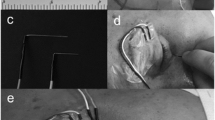Abstract
Objectives
Even in the days of modern microsurgery, the removal of a brain stem lesion remains a surgical challenge. Especially when operating on children, the prognosis is directly related to the radicality of the resection; however, a radical resection is often associated with surgical morbidity. Intraoperative neuromonitoring could help to minimise the surgical morbidity, but few studies have been performed to clarify the value of this monitoring. We investigated a prospective series of 21 patients with lesions involving the brain stem for the prognostic value and benefits of neuromonitoring.
Methods
We performed intraoperative neuromonitoring of cranial nerve function by electromyography (EMG) and motor evoked potential (MEP). The results were correlated with postoperative neurological deficits.
Conclusions
There is a good correlation between intraoperative neurophysiological events and postoperative neurological deficits in patients with lesions of the brain stem. In general, transient, prolonged, spontaneous activity in EMG is associated with a transient paresis of the respective muscle, whereas a permanent spontaneous activity is associated with a permanent deficit. Intraoperative neuromonitoring reliably predicts postoperative neurological function in patients with tumours of the lower brain stem and fourth ventricle. This neuromonitoring guides the neurosurgeon in the operation and may decrease surgical morbidity. We recommend using monitoring of MEP and EMG of the lower cranial nerves in surgery on all patients with lesions involving the lower brain stem and fourth ventricle.

Similar content being viewed by others
References
Pollack IF, Gerszten PC, Martinez AJ, Lo KH, Shultz B, Albright AL, Janosky J, Deutsch M (1995) Intracranial ependymomas of childhood: long-term outcome and prognostic factors. Neurosurgery 37:655–666 (discussion 666–667)
Lang J Jr, Ohmachi N, Lang J Sr (1991) Anatomical landmarks of the rhomboid fossa (floor of the 4th ventricle), its length and its width. Acta Neurochir (Wien) 113:84–90
Fahlbusch R, Strauss C (1991) Zur chirurgischen Bedeutung von cavernösen Hämangiomen des Hirnstammes. Zentralbl Neurochir 52:25–32
Radtke RA, Erwin CW, Wilkins RH (1989) Intraoperative brainstem auditory evoked potentials: significant decrease in postoperative morbidity. Neurology 39:187–191
Prass RL, Luders H (1986) Acoustic (loudspeaker) facial electromyographic monitoring: part 1. Evoked electromyographic activity during acoustic neuroma resection. Neurosurgery 19:392–400
Prass RL, Kinney SE, Hardy RW Jr, Hahn JF, Luders H (1987) Acoustic (loudspeaker) facial EMG monitoring: II. Use of evoked EMG activity during acoustic neuroma resection. Otolaryngol Head Neck Surg 97:541–551
Sala F, Krzan MJ, Deletis V (2002) Intraoperative neurophysiological monitoring in pediatric neurosurgery: why, when, how? Childs Nerv Syst 18:264–287
Moeller A (1995) Intraoperative neurophysiologic monitoring. Harwood, Luxembourg
Deletis V, Shils J (2002) Neurophysiology in neurosurgery — a modern intraoperative approach. Academic, Amsterdam
Legatt AD (2002) Mechanisms of intraoperative brainstem auditory evoked potential changes. J Clin Neurophysiol 19:396–408
Shchekut’ev GA, Lubnin A, Barkalaia DE, Sogomonian SA (1994) Monitoring of short latent evoked potentials during brain stem surgery. Anesteziol Reanimatol (5):48–52
Fahlbusch R, Strauss C, Huk W, Rockelein G, Kompf D, Ruprecht KW (1990) Surgical removal of pontomesencephalic cavernous hemangiomas. Neurosurgery 26:449–456 (discussion 456–457)
Wiedemayer H, Fauser B, Sandalcioglu IE, Schafer H, Stolke D (2002) The impact of neurophysiological intraoperative monitoring on surgical decisions: a critical analysis of 423 cases. J Neurosurg 96:255–262
Strauss C, Romstock J, Nimsky C, Fahlbusch R (1993) Intraoperative identification of motor areas of the rhomboid fossa using direct stimulation. J Neurosurg 79:393–399 (comment)
Morota N, Deletis V, Lee M, Epstein FJ (1996) Functional anatomic relationship between brain-stem tumors and cranial motor nuclei. Neurosurgery 39:787–793 (discussion 793–794)
Morota N, Deletis V, Epstein FJ, Kofler M, Abbott R, Lee M, Ruskin K (1995) Brain stem mapping: neurophysiological localization of motor nuclei on the floor of the fourth ventricle. Neurosurgery 37:922–929 (discussion 929–930)
Katsuta T, Morioka T, Fujii K, Fukui M (1993) Physiological localization of the facial colliculus during direct surgery on an intrinsic brain stem lesion. Neurosurgery 32:861–863 (comment 863)
Grabb PA, Albright AL, Sclabassi RJ, Pollack IF (1997) Continuous intraoperative electromyographic monitoring of cranial nerves during resection of fourth ventricular tumors in children. J Neurosurg 86:1–4
Eisner W, Schmid UD, Reulen HJ, Oeckler R, Olteanu-Nerbe V, Gall C, Kothbauer K (1995) The mapping and continuous monitoring of the intrinsic motor nuclei during brain stem surgery. Neurosurgery 37:255–265
Pechstein U, Cedzich C, Nadstawek J, Schramm J (1996) Transcranial high-frequency repetitive electrical stimulation for recording myogenic motor evoked potentials with the patient under general anesthesia. Neurosurgery 39:335–343 (discussion 343–344)
Yokoh A, Sugita K, Kobayashi S (1983) Intermittent versus continuous brain retraction. An experimental study. J Neurosurg 58:918–923
May DM, Jones SJ, Crockard HA (1996) Somatosensory evoked potential monitoring in cervical surgery: identification of pre- and intraoperative risk factors associated with neurological deterioration. J Neurosurg 85:566–573
Szalay EA, Carollo JJ, Roach JW (1986) Sensitivity of spinal cord monitoring to intraoperative events. J Pediatr Orthop 6:437–441
Moller AR (1995) Evaluating the benefits of intraoperative neurophysiological monitoring. Harwood, Luxembourg
Author information
Authors and Affiliations
Corresponding author
Rights and permissions
About this article
Cite this article
Gläsker, S., Pechstein, U., Vougioukas, V.I. et al. Monitoring motor function during resection of tumours in the lower brain stem and fourth ventricle. Childs Nerv Syst 22, 1288–1295 (2006). https://doi.org/10.1007/s00381-006-0101-z
Received:
Revised:
Published:
Issue Date:
DOI: https://doi.org/10.1007/s00381-006-0101-z




